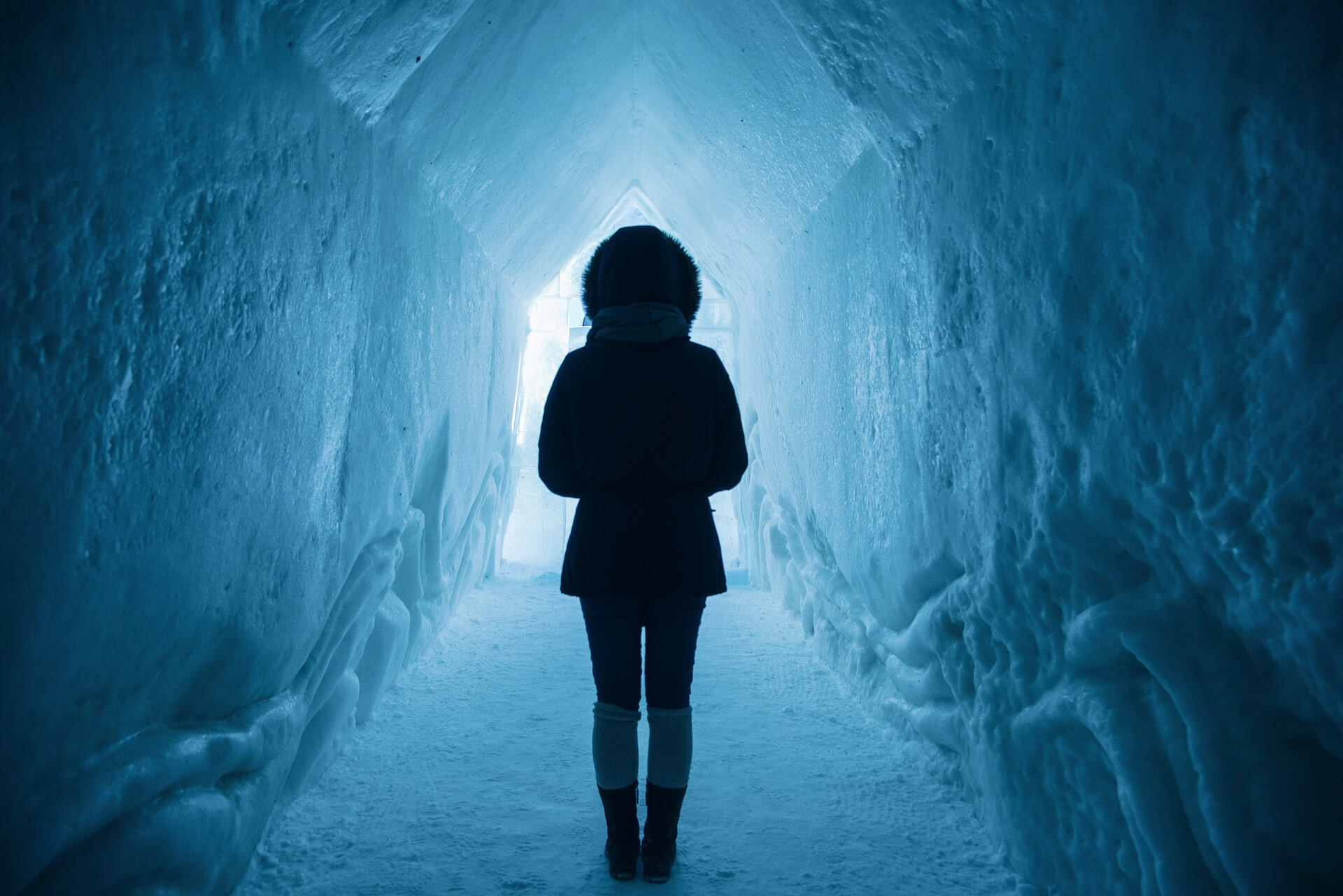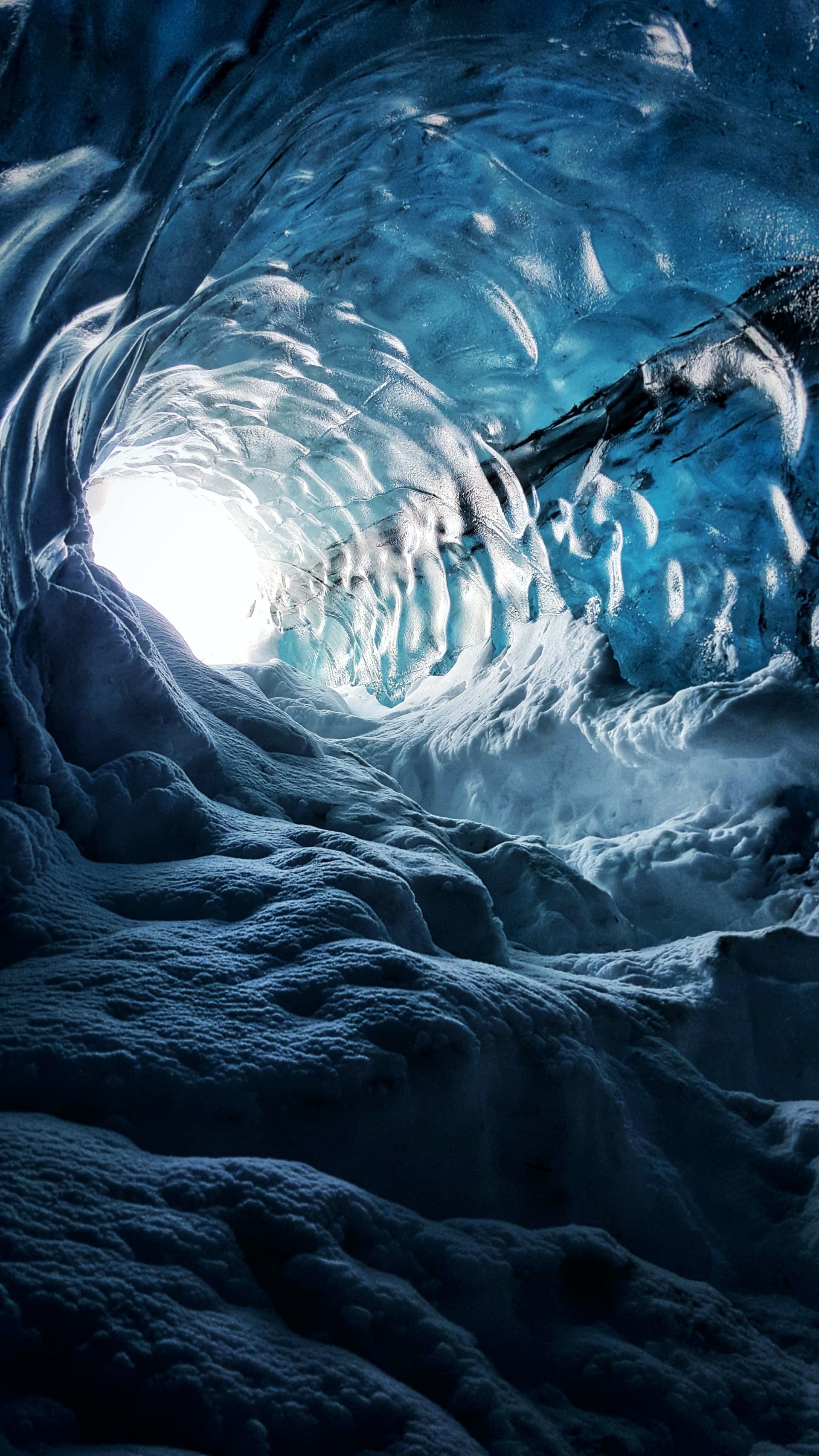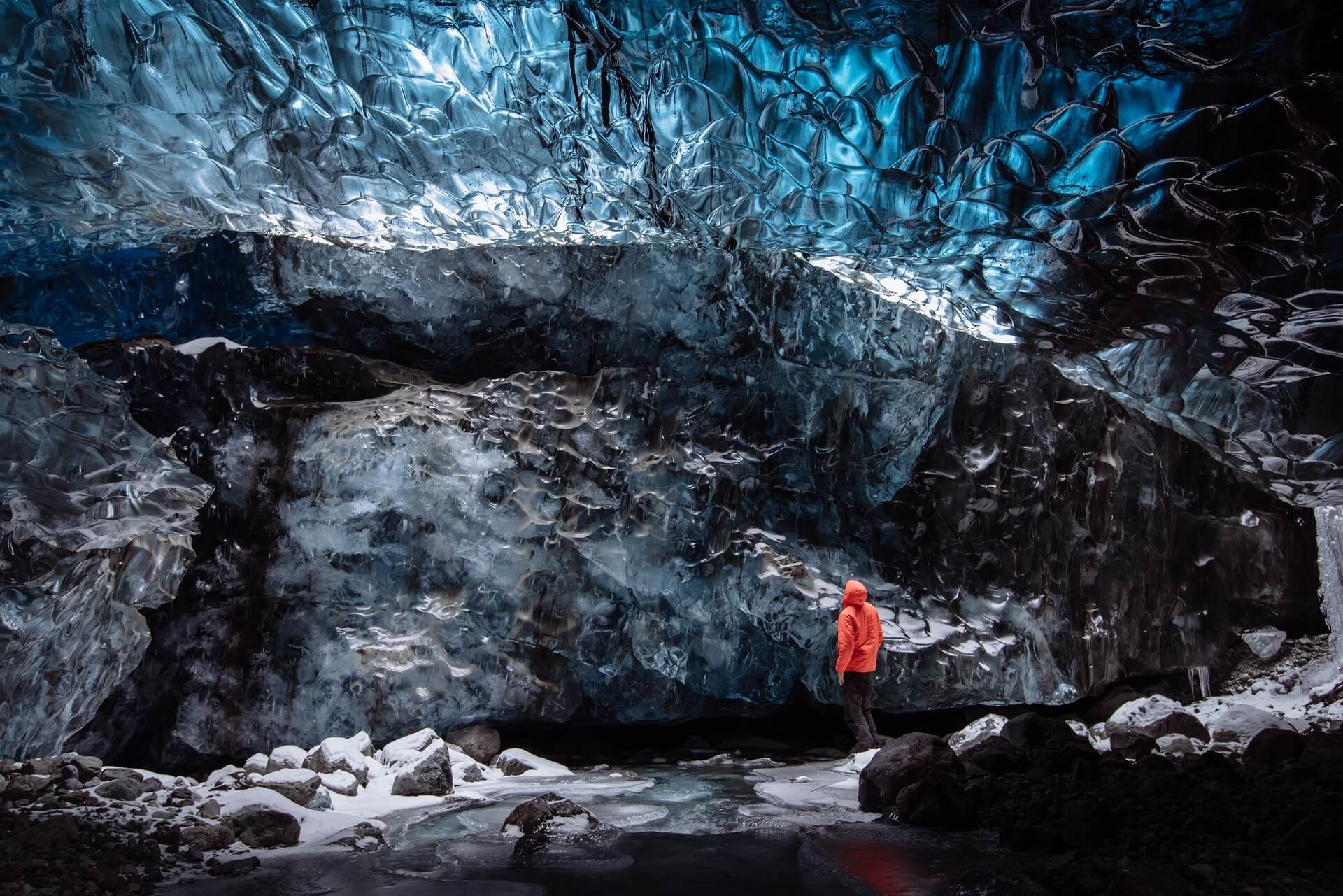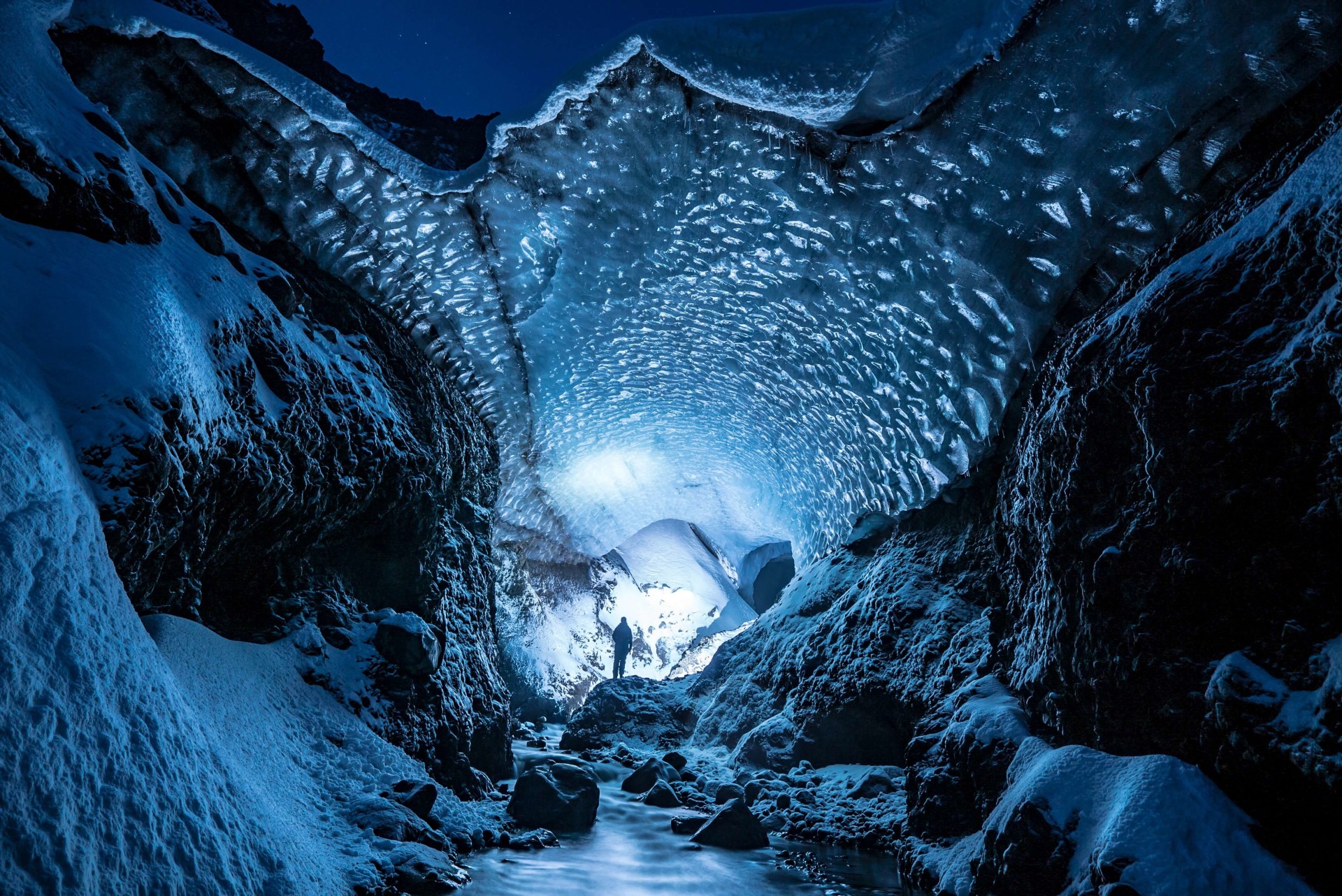Iceland is referred to as the land of ice and fire, thanks to the many glaciers and volcanoes found on the island. Glaciers have played an important role in shaping the beautiful landscapes of Iceland and still today over 11% of Iceland's territory is covered by glaciers.
Travelers who come to Iceland are often interested in the distinctive blue ice caves that are found around the country. Follow along on this guide, and we will answer your questions from why these caves are blue, what the best tour options are to experience the ice caves and where to find the most beautiful ice caves in Iceland.
Ice Caves vs. Glacier Caves: And Why it Matters
Chances are you've probably seen similar pictures as above when researching about your holiday in Iceland. Most people think these are ice caves when in fact the correct term is glacier caves. Ice caves can be any cave that has a significant amount of ice in it all year round. A glacier cave, on the other hand, is entirely made out of ice - as in the picture above.
These two terms often get confused and when people talk about the ice caves in Iceland, they are really referring to glacier caves. The reason this difference matter is that you do get both in Iceland, however, it's the glacier caves most tourists are interested in as these are the caves with the striking blue color.
We're not saying one is better than the other, but just make sure you know the difference before you book any tour; otherwise, you may be in for a surprise.
Most tours in Iceland refer to the glacier caves that can be found inside the famous Vatnajökull glacier. However, there are also tours to ice caves, such as the lava cave Lofthellir, which is filled with beautiful ice sculptures all year round. Glacier caves are only accessible during the winter months, whereas ice caves are accessible throughout the summer months as well.
How do Glacier Caves form?
Glacier caves are an entirely natural phenomenon that occurs in Iceland. Glaciers themselves are made out of dense ice that doesn't melt during the summer months. These glaciers are often found on top of mountains where it's cold all year round. Over many years the snow and ice accumulate and become the foundation of what is known as a glacier.
Glaciers can melt and shrink in size, but they can also keep growing larger as more layers of ice build-up. Some glaciers in Iceland have already disappeared completely, such as a former glacier that was known as Okjökull. It was officially declared dead in 2014 when all of the remaining ice melted away. Sadly, all of Iceland's glaciers are predicted to disappear completely within the next 200 years due to climate change.
The way glacier caves are formed is that these glaciers are constantly moving. As the ice melts, either through geothermal heat or during the summer months, the flowing water carves crevices and hollow spaces within these glaciers - this what is referred to as glacier caves. Because of the constant movement of glaciers, glacier caves are always changing as well and they can look completely different from season to season.
Why are the Ice Caves Blue in Iceland?
As mentioned above, glaciers are the result of years and years of snow and ice building up. This dense layer of ice is extremely heavy and it begins to compress out the air bubbles. Air bubbles give ice it's clear, white color. However, squeeze the air out of ice and it absorbs the color blue; this is why many glacier caves in Iceland have a distinctive electric blue color.
Ice caves are not only blue in color; you'll often find many other beautiful colors such as turquoise, white, grey or brown. The deeper into a glacier you get, the less light gets through, which means you'll get richer colors of blue and black ice. Black ice is either ice where there is little to no light, however, it can also occur when there is black ash and sand trapped within the ice.
Where are the best Glacier Caves of Iceland?
Glacier ice caves are constantly changing and evolving. Although it's the same glacier, the entrances to these caves are in a different location every year. What makes this special is that each visit is completely unique. If you go visit the glacier ice caves in this post, we guarantee you they will look completely different than in the photos here; as even just a few days or weeks can transform the icy landscape.
Vatnajökull Glacier in Iceland
How big is vatnajökull?
Vatnajökull is not only Iceland's largest glacier, but it's also the biggest in Europe. It covers 8% of Iceland's landmass, which makes it a brilliant source of beautiful glacier ice caves every year. In Iceland, if many glacier ice caves are discovered within close proximity to one another, the group of caves within that area are given a name to make it easier to distinguish between the various locations.
For example, the Crystal Cave is a name that's given to a large cave in Vatnajökull. Since the winter of 2011, this cave has appeared in approximately the same location. The Crystal Cave has formed as a result of a fairly large glacial river each summer. It's one of Iceland's largest and most popular glacier caves and it was given its name thanks to the inside resembling a crystal glass dome. The Crystal Cave is big enough to fit around 70 to 100 people at once.
Around the corner of the Crystal Cave, a smaller cave has formed in recent years called Dark Rubin. It's a much smaller cave with a capacity of only 20 people. What makes the Dark Rubin cave so spectacular is that it's entirely made of black ice. Little light enters the ice in this cave which makes the walls look as if they are made of black marble.
Many other stunning caves have appeared and disappeared in recent years, such as the Blue Diamond Cave. As we mentioned before, a glacier ice cave may be discovered one year and yet be gone within a few months. Depending on when you visit Iceland, there will be new and equally beautiful ice caves available to explore.
The Katla Ice Cave in Southern Iceland
Katla is notoriously known as one of Iceland's most dangerous volcanoes. However, recent ice cave discoveries in the glacier above the volcano reveal a more fragile and beautiful side to this volcanic giant. The Katla ice caves have been found to contain less blue ice and are far darker than the Vatnajökull. Moreover, the caves are smaller with shorter ice tunnels.
However, don't let this put you off as even the shorter and darker tunnels are stunning, and the fact you're above the Katla volcano adds to the experience. Katla is easier to get to from Reykjavik, which makes its location ideal for anyone who doesn't have much time in Iceland. The glacier ice caves in Katla are also accessible all year round, which isn't always the case for the Vatnajökull caves.
Ice Caves in the Langjökull Glacier
The Langjökull Glacier is Iceland's second-largest glacier and is found only 150 kilometres (93 miles) from Reykjavík. It's a popular stop for tourists visiting the famous Golden Circle route. There are both naturally formed glacier ice caves in Langjökull, as well as a man-made tunnel. In fact, Langjökull contains the world's largest man-made ice tunnel. It's the result of many top glaciologists and engineers, who have created a cave that basically looks like it was created by nature. This man-made tunnel has the added bonus that it's accessible all year round!
The naturally occurring ice caves have come and gone in the last few years, but as we mentioned before - make sure to check what tours are running before you go. In recent years the glacier has also attracted many adventure seekers who hike or snowmobile on top of the glacier.
What types of ice cave tours are offered in Iceland?
There's no shortage of ice cave tours in Iceland. As we mentioned above, make sure you know where your tour will bring you as there is a difference between glacier caves and ice caves! Also, please bear in mind that you should never try to enter a glacier cave on your own, no matter how experienced you think you are. Only enter glacier caves with an experienced glacier guide. These guides will have a whole host of information available to them in order to make the decision as to whether a cave is safe to enter or not.
Day Tour
There are a number of day tours available to ice caves from Reykjavik. If you're based in the capital with no means of transportation then let yourself be picked up by 4x4 minibus in Reykjavik and enjoy a day of exploring southern Iceland, along with entering a glacier cave near Katla. This tour is a once in a lifetime adventure where you'll see many of Iceland's most beautiful landscapes and landmarks.
If you're just looking for the glacier ice cave tour then you can join the Skaftafell Blue Ice Cave Adventure & Glacier Hike Tour. During this tour, you'll hike up Vatnajökull, one of Europe's largest glaciers and explore the majestic blue ice caves.
Multi-Day Tour
Depending on how much time you've got in Iceland, we also recommend joining one of the multi-day tours. During some winters there are so many caves around the island that it's not possible to see it all in one day. This 2 Day Blue Ice Cave & South Coast: Glacier Hike, Jokulsarlon & Northern Lights Tour, is filled with everything Iceland is known for: black sand beaches, ice caves, northern lights, and much more - all packed into a 2-day tour.
When is the best time to visit Glacier Ice Caves in Iceland?
Most glacier ice caves in Iceland are only accessible in the winter months, between November and March. These caves freeze during the cold temperatures of the winter and melt into rivers during spring and summer. So if you want to guarantee seeing an ice cave during your time in Iceland then we recommend going in the winter.
Does that mean you can't see ice caves in the summer? There's no simple answer to this question. It is true that the majority of ice caves are inaccessible during the summer as this is when the caves melt and reform. However, occasionally some of the caves are safe to enter year-round, even in the summer.
For example, an ice cave discovered during the winter of 2017-2018 in Kötlujökull was stable for the entire year, which means tourists were able to go check it out in the summer. This isn't always guaranteed and no one ever knows whether it will be possible or not, so again, if you really want to see an ice cave in Iceland then we recommend traveling in the winter months.
Other options exist during the winter, such as the man-made cave in Langjökull, which you can enter year-round. This cave was carved deep into the glacier in order to provide visitors with a chance to glimpse inside a glacier no matter what time of year they came to Iceland.
A Photography Guide on How to Get the Perfect Ice Cave Picture
Getting the perfect glacier ice cave picture can be extremely satisfying, but it's not easy as there isn't much light. It might seem like an effortless picture, but many of the photographs you see of ice caves were a challenge to capture.
When you're standing inside of an ice cave, it might not seem completely dark to the human eye. However, a camera lens is much worse at absorbing light than we are. It's like capturing the night sky on a beautifully starry evening; it looks amazing to the eye but on camera, it's completely black.
In fact, the camera settings you should be aiming for are similar to those of night photography. If you're interested in photographing the Northern Lights then these steps will sound very similar. In order to capture more light, you'll need a longer exposure time, which also means you'll require a tripod to keep the camera still. Taking a perfectly sharp photo inside of an ice cave can be a challenging task that's nearly impossible.
Using auto-focus might work, however, we recommend switching to manual focus for lower light settings. A good approach is to face the camera towards the entrance in order to get as much light as possible. Keep your ISO level anywhere below 500 ISO if possible, the higher the ISO the grainer your picture becomes.
Use a shutter release remote or the self-timer function in order to take the picture; this will ensure you don't make the image blurry by moving the camera. Play around with various exposure times, as each cave is different. Most importantly, have fun and enjoy the glacier ice caves around you!
What to Wear for a Glacier Ice Cave Tour?
Water melts above 0°C (32°F), which means the temperature within the caves is often at 0°C (32°F) or below. We recommend always dressing warm, no matter what season you go to visit a glacier ice cave. With any glacier tour, you will be provided with the correct safety equipment, which includes a hardhat.
To stay warm and to have a comfortable and fun tour we recommend bringing:
- A warm jacket that's wind and waterproof
- A light jumper/sweater or fleece
- Comfortable trousers that are ideally waterproof
- Gloves
- A thin hat that can be worn under your hardhat
- Hiking or walking shoes
- Warm and comfortable hiking shoes

Museums & Exhibitions on Ice Caves and Glaciers in Iceland
The Ice Cave in Perlan Museum
Did you know there is an ice cave in the heart of Reykjavik? It's a 100-meter long man-made cave and it's situated directly inside the fantastic Perlan Museum. If don't have time to visit a real glacier cave or if you're visiting in the summer months then we definitely recommend checking out this exhibition.
Not only can you walk through the twists and turns of the ice cave - with 350 tons of snow and ice from the Blue Mountains. However, you'll get the chance to learn more about glaciers and different ice formations along the way. As well as the Glacier and Ice Cave exhibition at Perlan Museum, the museum also offers other great exhibitions on volcanoes, earthquakes and climate change.
Speaking of climate change - did you know that Iceland's glaciers are predicted to melt away completely in the next 200 years? So if you're unsure whether to join an ice cave tour then please remember that they won't be around forever. So what are you waiting for?




